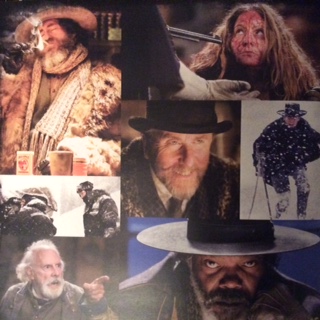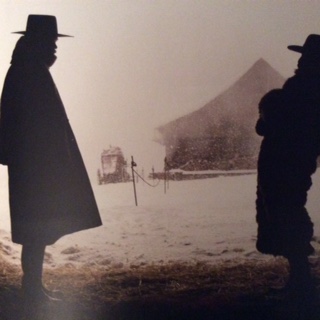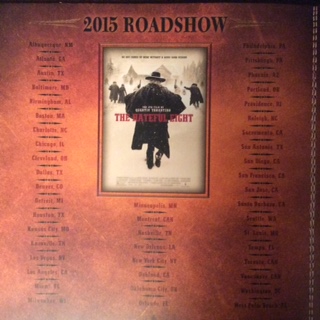(USA 2015)
The trailers piqued my interest but didn’t totally sell me, so I wasn’t sure about The Hateful Eight. My apprehension was unfounded: it’s gotdamn motherfucking Quentin Tarantino, all the motherfucking way, motherfucker. If that last sentence sounds good to you—and you read it how Jules Winnfield might say it—well, you’re in for a treat. I said, goddamn, god damn!
Traveling through Wyoming on the way to Red Rock not long after the Civil War, bounty hunter Major Marquis Warren (Samuel L. Jackson) is caught in the mountains just as a blizzard is a-brewing. He stops a stagecoach that happens to be carrying another bounty hunter, John “The Hangman” Ruth (Kurt Russell), and his captive, the lovely Daisy Domergue (Jennifer Jason Leigh)—who has blood on her face for nearly the entire film—and finagles a ride. Another guy, Chris Mannix (Walton Goggins), who claims to be en route to Red Rock to become sheriff, is thrown into the mix. The blizzard forces them to seek shelter at Minnie’s Haberdashery, where they join four strangers: “Mexican Bob” (Demian Bichir), smarmy Oswaldo Mobray (Tim Roth), quiet cowboy Joe Gage (Michael Madsen), and “The General” (Bruce Dern), a frail former Confederate soldier. Niceties, banter, and then expletives are exchanged until characters are killed off, Ten Little Indians style but with twists—Agatha Christie never blew anyone’s nuts off. Then again, Tarantino’s way of telling a story is completely his own.
True to form, Tarantino jams The Hateful Eight with memorable miscreants, snappy dialogue, and impossibly crazy cutthroat situations. The action here is intense and suspenseful, unfolding gradually and teasingly. The timing is out of sequence—no shock there. The plot gets thicker with each character that falls off, leaving questions begging for answers. Best of all, not a single performance is subpar and not a single character—except maybe Minnie’s helper—is superfluous. Russell and Dern stand out, but Jackson is a master scene-stealer—his delivery is so strong that you simply cannot turn away when he speaks. Channing Tatum makes a surprise appearance and gives an even more surprisingly impressive performance.
Well, let’s not start sucking each other’s dicks quite yet. The story has a hole or two, and the gore is so over the top it loses its impact at points. There’s the use of the ‘n’ word like a mere conjunction. Jason Leigh sounds annoyingly like Roseanne Barr. Oh yeah—more than eight characters actually appear, which a couple of times—namely when everyone is in the same small room—requires extra concentration to follow along. All that said, though, none of it detracts from enjoying the film. Yes, it lacks the elegance and grace of Kill Bill, my personal favorite, but The Hateful Eight is toward the top of Tarantino’s resume. I loved every minute—which did not seem like three hours.
Side note: the overall experience was one I’ve never had at a movie theater. Truly a bona fide “event,” the atmosphere was like a rock concert: the screening was sold out ahead of time, and the crowd was abuzz with excited fans taking pictures and chattering about other Tarantino films. Some had on Reservoir Dogs and Kill Bill tee shirts. The line to get in was all the way to the next block. Programs were provided. Shot on decadent 70-millimeter film, the Music Box showed The Hateful Eight on a brand spanking new screen it acquired for this special “roadshow engagement.” The price was double a normal ticket but oh so worth it.
The Hateful Eight ended my year of movies on a high note—I can’t think of a better director to release a new film to close out the year. To borrow from it, “Old Mary Todd is calling, so it must be time for bed.” Time will tell for sure, but I think this one belongs to the ages.
(Music Box) A+






